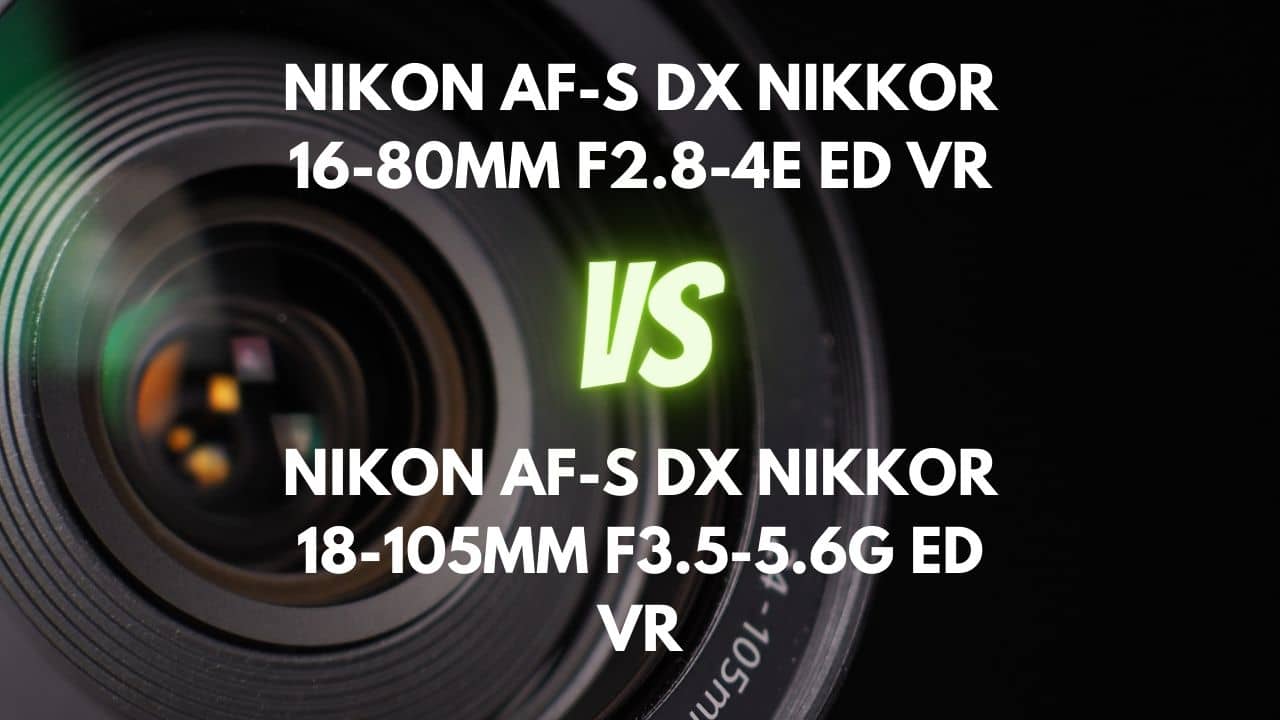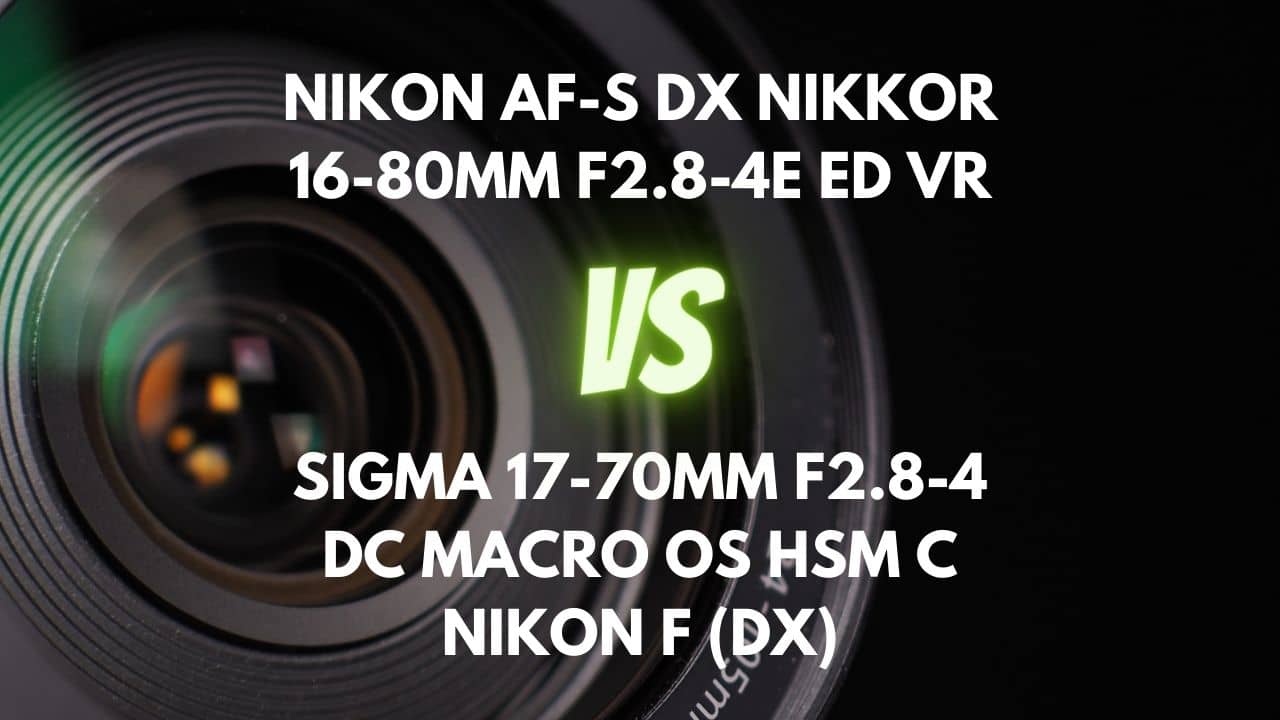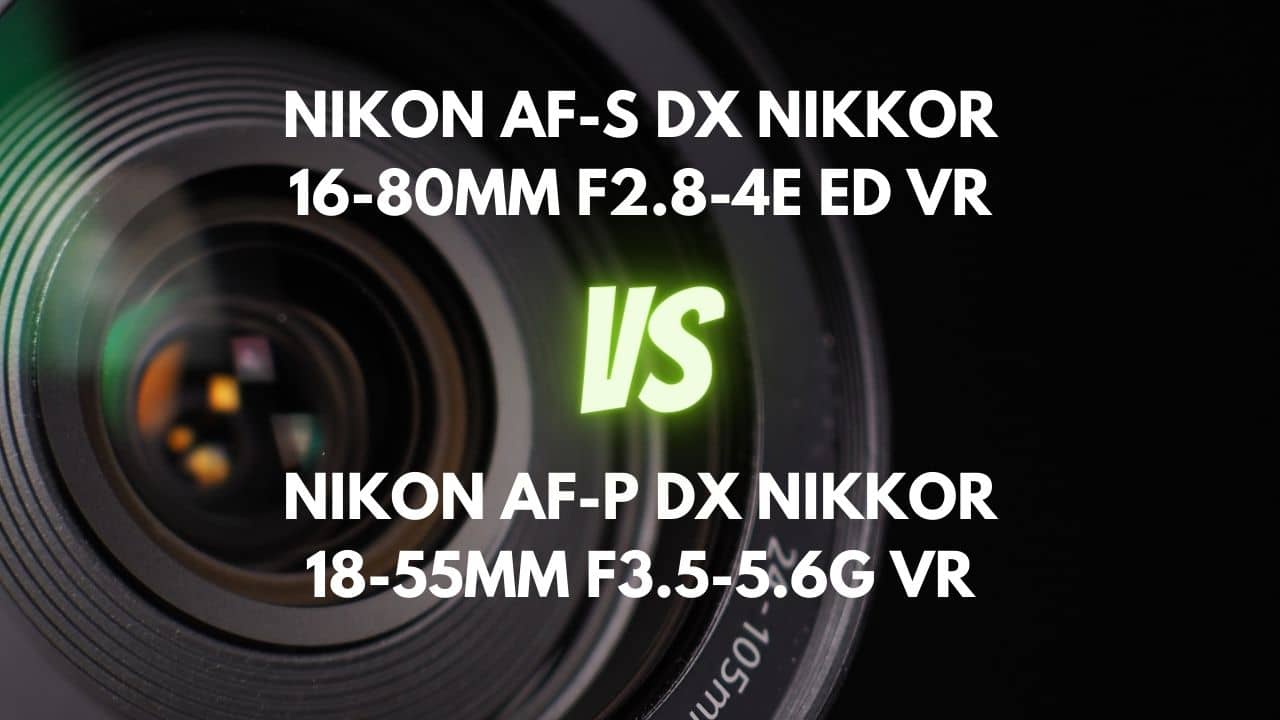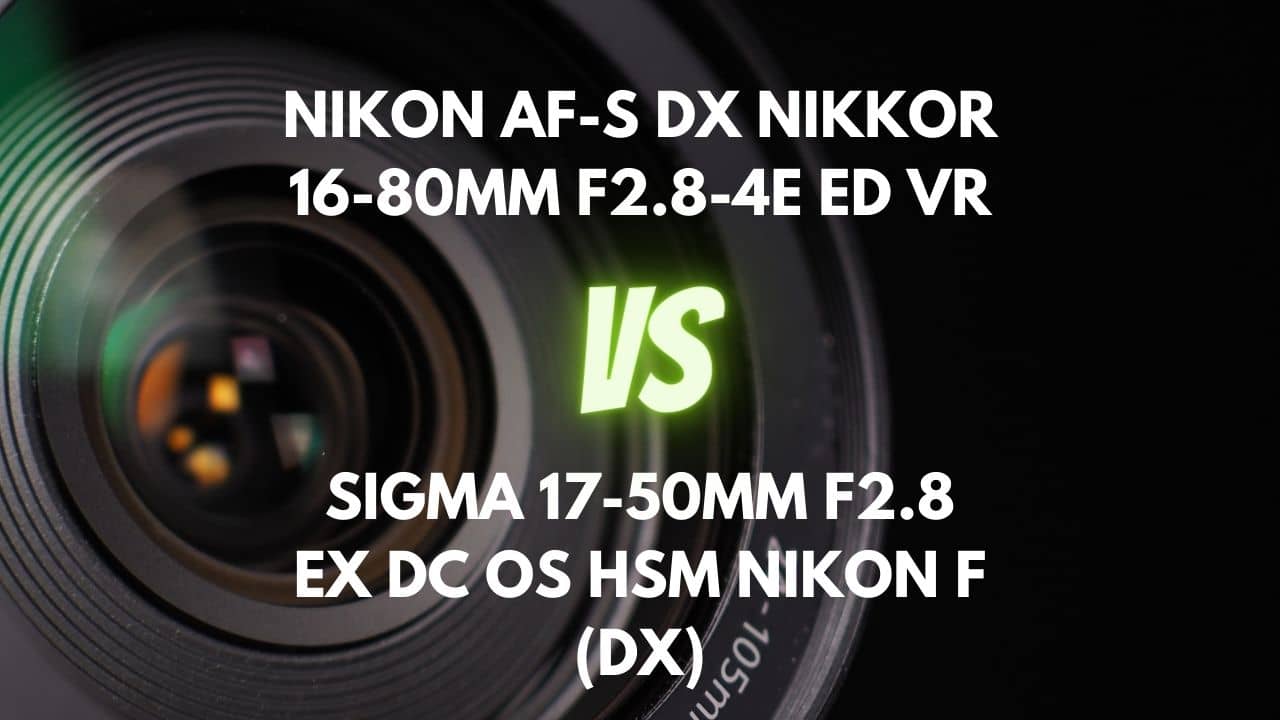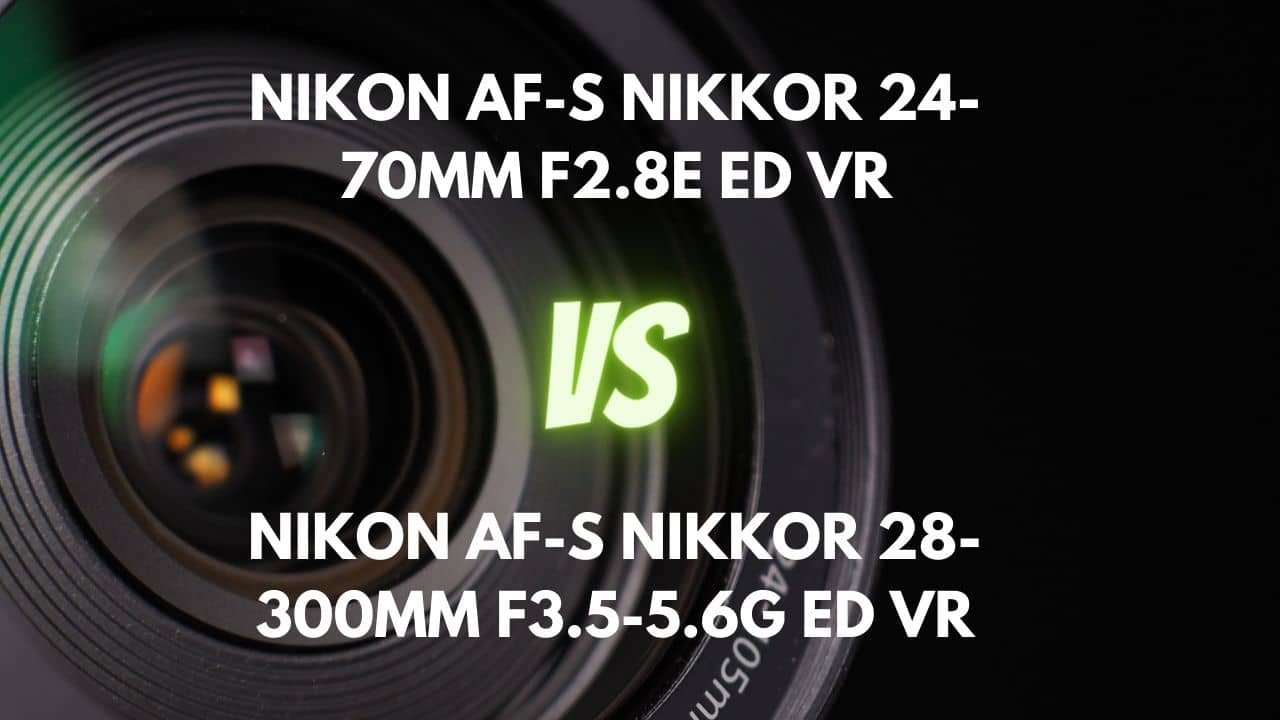In the world of photography, the quest for the perfect lens is never-ending. Whether you’re a professional photographer, an enthusiastic hobbyist, or somewhere in between, finding the right balance between performance, versatility, and affordability is key.
Today, we’re diving into an exciting comparison between two popular Nikon zoom lenses: the Nikon DX 16-80mm f/2.8-4 and the Nikon DX 16-85mm f/3.5-5.6. Both lenses boast a range of features and capabilities that make them compelling choices for photographers looking to enhance their arsenal.
Join us as we take a closer look at these two versatile lenses, scrutinizing their strengths, weaknesses, and unique characteristics.
In our comprehensive comparison, we’ll explore aspects such as build quality, ergonomics, focusing performance, image stabilization, and optical qualities to help you make an informed decision on which lens best suits your photography needs and budget.
So, let’s zoom in and discover which contender emerges victorious in this battle of versatility!
Overview
| Nikon AF-S DX NIKKOR 16-80mm F2.8-4E ED VR | Nikon AF-S DX NIKKOR 16-85mm F3.5-5.6G ED VR | |
|---|---|---|
| Max Aperture | F2.8-4.0 | F3.5-5.6 |
| Aperture Type | Variable | Variable |
| Focal Range (mm) | 16-80 | 16-85 |
| Mount Type | Nikon F (DX) | Nikon F (DX) |
| Zoom Ratio (X) | 5 | 5.3 |
The Nikon DX 16-80mm f/2.8-4 lens offers a larger maximum aperture compared to the Nikon DX 16-85mm f/3.5-5.6 lens, which means it performs better in low light situations and can create a shallower depth of field for subject isolation.
Both lenses have a variable aperture and are designed for Nikon F (DX) mount cameras. The 16-80mm lens covers a zoom range of 5x, while the 16-85mm lens offers a slightly longer reach with a 5.3x zoom ratio.
The 16-80mm f/2.8-4 lens has some advantages in low light performance, depth of field control. The 16-85mm lens offers a longer focal range and might be a better choice for photographers prioritizing versatility.
Design and Ease of Use
| Nikon AF-S DX NIKKOR 16-80mm F2.8-4E ED VR | Nikon AF-S DX NIKKOR 16-85mm F3.5-5.6G ED VR | |
|---|---|---|
| Diameter x Length (mm) | ⌀80×85.5mm | ⌀72×85mm |
| Weight (gr) | 480 | 485 |
| Filter Thread (mm) | 72 | 67 |
| Weather Sealing | No | No |
| Zoom Method | Rotary (internal) | Rotary (extending) |
| Zoom Lock | No | No Zoom |
| Distance Scale | Yes | Yes |
| DoF Scale | No | No |
| Hood Supplied | Yes | Yes |
| Hood Code | HB-75 | HB-39 |
The Nikon DX 16-80mm f/2.8-4, with dimensions of ⌀80×85.5mm and weighing 480 grams, features an internal rotary zoom method. This design choice results in a lens that doesn’t change its physical size when zooming, making it easier to handle and more compact overall. Furthermore, internal zoom lenses tend to have better weather sealing and consistent balance while zooming.
In contrast, the Nikon DX 16-85mm f/3.5-5.6 has dimensions of ⌀72×85mm and weighs slightly more at 485 grams. This lens utilizes an extending rotary zoom method, which means the lens physically extends when zooming in or out. While this design is generally simpler and potentially lighter, it can make the lens more cumbersome to handle, harder to weather seal, and may affect the camera’s balance during zooming.
If you prioritize a compact design, better weather sealing, and consistent balance while zooming, the 16-80mm f/2.8-4 lens is the superior choice. However, if you value simplicity in lens design and are less concerned about weather sealing and changes in balance while zooming, the 16-85mm f/3.5-5.6 lens might be more suitable for your needs.
Lens Mount and Barrel
The Nikon DX 16-80mm f/2.8-4 features a sturdy metal lens mount with a rubber seal around it to protect against dust entering the camera body. Its lens barrel is crafted from lightweight plastic, with rubberized rings for focus and zoom. Remarkably, the lens doesn’t change its physical size when you zoom in or out, maintaining a compact and easy-to-handle design.
On the other hand, the Nikon DX 16-85mm f/3.5-5.6 boasts a durable metal lens mount with a robust weather sealing gasket around its edge. Its lens barrel is primarily constructed from high-quality plastics, offering a sleek and professional finish. Rubberized zoom and focus rings ensure a secure grip, while an ergonomic bevel enhances handling. However, unlike its counterpart, this lens barrel extends when zooming, telescoping out by approximately 42mm, but still remains compact and well-balanced on various camera bodies.
Both plastic and metal lens barrels have their advantages, with plastic offering a lighter and more affordable option, while metal provides increased durability and a premium feel. Similarly, different materials used in lens mounts, such as metal alloys, plastics, composites, or magnesium alloy, offer a range of properties that cater to various needs of photographers.
Ultimately, neither the 16-80mm f/2.8-4 nor the 16-85mm f/3.5-5.6 lens mount and barrel can be deemed universally superior, as the choice depends on individual preferences and priorities. If you value a compact lens that doesn’t change size when zooming and a metal lens mount with a rubber seal, the 16-80mm f/2.8-4 lens might be the better option. However, if a weather-sealed metal lens mount and a sleek, high-quality plastic barrel are more important to you, the 16-85mm f/3.5-5.6 lens could be the right choice.
Weather Sealing
The Nikon DX 16-80mm f/2.8-4 features a partial weather sealing, with a rubber gasket around the lens mount to prevent dust from entering the camera body. Additionally, the front element has a fluorine coating that repels water, making it easier to clean. While this lens is not fully weather-sealed, it offers some protection against dust and light moisture.
On the other hand, the Nikon DX 16-85mm f/3.5-5.6 boasts a more robust weather sealing, with a hefty gasket around the metal lens mount, providing better protection against environmental elements.
Weather sealing is an essential factor to consider when shooting in various conditions, as it ensures the durability and performance of the lens. While both lenses offer some degree of weather sealing, the 16-80mm f/2.8-4 has a clear advantage with its more comprehensive sealing design.
In conclusion, if you prioritize weather protection and frequently shoot in unpredictable or challenging conditions, the 16-80mm f/2.8-4 with its superior weather sealing would be the better choice. However, if you mostly shoot in controlled environments or indoors, the 16-85mm f/3.5-5.6 may still offer adequate protection for your needs.
Rings
The Nikon DX 16-80mm f/2.8-4 features 2 rings: a large, rubberized zoom ring at the front and a narrower manual focusing ring at the rear. The zoom ring provides a sturdy grip and movement, though slightly heavy.
The manual focusing ring is less ergonomically friendly, with a grinding feel and harder-to-locate placement. It takes a third of a turn from infinity to the minimal focus distance, and a focus distance scale window lies between the two rings.
In contrast, the Nikon DX 16-85mm f/3.5-5.6 has 2 rubber-ribbed rings for zoom and focus control. The zoom control rotates about 90 degrees with firmness and no zoom creep. The focus control rotates about 130 degrees, allowing for easy manual focusing. The zoom ring turns smoothly, though it stiffens beyond 50mm. A windowed distance scale is present, but there is no depth-of-field indicator or extension lock switch on the zoom ring.
Comparing the two lenses, the 16-85mm f/3.5-5.6 lens offers better ergonomics, with its rubber-ribbed rings providing a comfortable grip and smoother operation. The focus control rotation allows for easier manual focusing and more precise control. The 16-80mm f/2.8-4 lens has a sturdy zoom ring but falls short with its manual focusing ring.
In conclusion, the 16-85mm f/3.5-5.6 lens has a superior ring design, providing better ergonomics, precision, and control over focus and zoom adjustments. This lens is likely to enhance your shooting experience and overall handling, making it the preferable choice between the two lenses based on ring design.
Switches/Buttons
The Nikon DX 16-80mm f/2.8-4 is equipped with 3 switches/buttons on the barrel. The first is an AF/MF switch, which enables manual override of autofocus with minimal lag time, regardless of the AF mode in use. The second switch controls the 4-stop vibration reduction system (IS switch), while the third allows you to select between Normal and Active VR modes. Although the switches are clearly labeled, they are identical in appearance, potentially making it challenging to adjust settings quickly while the camera is raised to your eye.
On the other hand, the Nikon DX 16-85mm f/3.5-5.6 features 3 switches/buttons as well. One switch activates and deactivates autofocus with the option of manual override (AF/MF switch), the next enables and disables Vibration Reduction with two modes to choose from (IS switch), and the last sets the VR mode sensitivity level (normal or active).
The switches are well-designed and easy to use, simplifying the process of switching between different modes as needed. The label on the switch that toggles between autofocus and manual focus modes reads “M/A M.” This signifies the capability for instant manual override while using autofocus, enabling the focus ring to be rotated at any moment to switch to manual focus mode. Overall, the switches contribute to the user-friendliness of the lens.
Filter Thread
The Nikon DX 16-80mm f/2.8-4 features a 72mm plastic filter thread. Its front element remains stationary during focusing, ensuring ease of use with various filters. Although not compatible with larger 77mm filters, the lens incorporates internal focusing, preventing polarizing or ND grad filters from spinning around.
In contrast, the Nikon DX 16-85mm f/3.5-5.6 sports a 67mm plastic filter thread. Like the other lens, its front element doesn’t rotate during focusing or zooming, making it simple to use with polarizers and graduated filters. Impressively, even when using a double-stack of filters 11mm thick (excluding rear threads), vignetting is not an issue.
In conclusion, both lenses offer user-friendly filter thread designs with stationary front elements, ensuring compatibility with various filters. However, the 16-85mm f/3.5-5.6 lens has a slight edge due to its smaller 67mm filter thread also provides a more affordable and lightweight option compared to the 72mm filter thread of the 16-80mm f/2.8-4 lens.
Lens Hood
The Nikon DX 16-80mm f/2.8-4 lens hood is a unique and thoughtfully designed addition to the package. It features a distinctive squared petal-style shape, which sets it apart from the usual rounded or petal designs.
Crafted from durable hard plastic with a matte finish, this lens hood not only protects against stray light but also provides a comfortable grip during attachment or detachment, thanks to its ergonomic bevel. The innovative lock button ensures smooth rotation and a secure fit, minimizing the risk of wear and tear compared to traditional twist-on/click hoods.
On the other hand, the Nikon DX 16-85mm f/3.5-5.6 lens hood is a reliable, petal-shaped accessory that comes in the package. Made from lightweight plastic material, it performs well in reducing extraneous light, preventing flare, and maintaining image contrast. It fits firmly on the lens, ensuring optimal performance. However, at 85mm, it’s not as effective in blocking stray light as it is at wider angles.
While both lens hoods are valuable additions, the 16-80mm f/2.8-4 lens hood steals the spotlight with its innovative design, ergonomic grip, and lock button mechanism. This superior lens hood not only provides better functionality but also adds a touch of creativity and distinction to your photography toolkit.
Focusing and Optical Stabilization
| Nikon AF-S DX NIKKOR 16-80mm F2.8-4E ED VR | Nikon AF-S DX NIKKOR 16-85mm F3.5-5.6G ED VR | |
|---|---|---|
| Autofocus | Yes | Yes |
| AF Motor | Silent Wave Motor | Silent Wave Motor |
| Rotating Front Element | Does not rotate on focusing | Does not rotate on focusing |
| Min Focus Distance | 0.35m | 0.38m |
| Max Magnification (X) | 0.22 | 0.22 |
| Full-Time Manual Focus | Yes | Yes |
| Focus Method | Internal | Internal |
Focusing Performance
The Nikon DX 16-80mm f/2.8-4 boasts impressive autofocus performance with quick and accurate focusing, making it suitable for various shooting situations. Its relatively quiet focusing mechanism is a boon for both photography and video applications. In low-light conditions, the lens maintains its autofocus accuracy and speed, allowing for prompt initial autofocus acquisition.
The lens supports manual focus override for fine-tuning and features a smooth, precise manual focus action. Its internally focusing design ensures a constant length, which is advantageous for photographers using filters or accessories. With minimal focus breathing, this lens is a top choice for videographers and photographers requiring consistent framing during focus adjustments.
In contrast, the Nikon DX 16-85mm f/3.5-5.6 utilizes an AF-S motor for fast and near-silent autofocus operations. Though accurate, its autofocus speed is average, and the lens produces a quiet whirring sound. With an internally focusing design, the ultrasonic motor facilitates the manual focus override with a seamless manual focus action. The lens has a reasonable initial autofocus acquisition speed but displays significant focus breathing and may produce an audible squeak during focusing.
In the battle of focusing performance, the 16-80mm f/2.8-4 lens takes the crown with its rapid, accurate autofocus, low-light capabilities, and minimal focus breathing. Its versatility makes it a superior choice for photographers and videographers seeking top-notch focusing performance in various shooting conditions.
Optical Stabilization
The Nikon DX 16-80mm f/2.8-4 features a Vibration Reduction (VR) system with 4 stops of compensation, which allows for sharp images at slower shutter speeds. It has two modes – Normal and Active, with Active being more suited for shooting from a moving platform. At 16mm, you can achieve sharp shots at 1/3 of a second, and at 80mm, it’s possible to get sharp shots at 1/4 of a second even with some hand movement. However, the stabilization performance may vary based on individual shooting conditions and photographer steadiness.
On the other hand, the Nikon DX 16-85mm f/3.5-5.6 boasts a second-generation optical stabilization system (VR II) that also provides up to 4 stops of compensation. In addition to the normal mode, this system features an active mode that is highly responsive to camera movement. The VR II system is effective in low-light situations, helping to keep still shots sharper and video footage smoother.
While optical stabilization is not as essential for wide-angle photography, it can be beneficial in certain situations like low-light conditions, handheld shooting, or when recording video. Both lenses offer similar optical stabilization performance with 4 stops of compensation.
Image Quality
| Nikon AF-S DX NIKKOR 16-80mm F2.8-4E ED VR | Nikon AF-S DX NIKKOR 16-85mm F3.5-5.6G ED VR | |
|---|---|---|
| Special Elements | 4 ED and 3 aspherical elements. Nano Crystal Coat. | 2x ED glass elements and 3x aspherical lens elements |
| Diaphragm Blades | 7 | 7 |
| Circular Aperture | Yes | Yes |
Aberration
The Nikon DX 16-80mm f/2.8-4 demonstrates good control of chromatic aberration, with only noticeable fringing at 16mm that can be easily corrected in-camera or during post-processing. Spherochromatism, an advanced form of chromatic aberration, is absent in this lens. Coma is also well-managed, with a minimal amount visible at specific settings, which disappears as the lens is stopped down. However, spherical aberration is present at the extreme end of the lens’s focusing distance, causing a loss of contrast and requiring post-processing for high-impact images.
Compared to the aforementioned system, the Nikon DX 16-85mm f/3.5-5.6 exhibits exceptional control over chromatic aberration across its entire range of focal lengths. Even at its maximum telephoto length of 85mm, chromatic aberration amounts to a mere 5/100ths of a percent of the frame height, and is almost imperceptible between 24mm and 70mm. The three aspherical lens elements included in the design of this lens effectively address coma and spherical aberration, minimizing these types of lens distortion. Nonetheless, some field curvature in the extreme corners and a slight focus shift when stopping down may be observable at 16mm due to residual spherical aberrations.
Considering the overall aberration performance, the 16-85mm f/3.5-5.6 lens emerges as the superior choice. Its excellent control of chromatic aberration throughout the entire zoom range, along with the effective management of coma and spherical aberration, make it a more reliable option for photographers seeking minimal distortion and high-quality images.
Sharpness
The Nikon DX 16-80mm f/2.8-4 boasts impressive sharpness at most zoom settings, particularly in the center. However, corner sharpness can suffer at wider focal lengths and wide-open apertures. By stopping down to around f/5.6-8, corner sharpness improves significantly. The sharpest aperture varies with focal length, but typically falls within the f/5.6-8 range.
On the other hand, the Nikon DX 16-85mm f/3.5-5.6 is consistently praised for its sharpness. It delivers excellent results even at maximum aperture and in the center of the frame. Sharpness is evenly distributed across the frame, with only slight variations when shooting specific test subjects at full aperture and enlarging images.
Corner sharpness is generally good, with some minor softness at 16mm or 85mm when used wide open. When the aperture is set to f/5.6 or f/8, the lens produces superb sharpness that extends across the entire frame. The sharpest aperture varies with focal length but is generally found at f/5.6 or f/8.
In conclusion, the 16-85mm f/3.5-5.6 lens stands out as the superior option in terms of sharpness. Its consistently excellent performance across the entire frame, along with remarkable sharpness at both maximum aperture and various focal lengths, makes it an ideal choice for photographers who prioritize image clarity and detail.
Bokeh Quality
The Nikon DX 16-80mm f/2.8-4 offers varying bokeh quality depending on the settings used. At 80mm and near the minimum focusing distance, the bokeh is smooth and pleasing, making it suitable for flowers and small subjects.
However, at other focal lengths and apertures, the out-of-focus areas may not be as smooth or attractive, and can even exhibit hard edges or onion bokeh. Achieving the softest backgrounds requires zooming to the longest focal length, getting as close as possible to the subject, and shooting at the largest aperture. Overall, the bokeh produced by this lens is not Nikon’s finest.
Bokeh quality with the Nikon DX 16-85mm f/3.5-5.6 varies. While the bokeh produced at 85mm f/5.6 is satisfactory for general blur and highlights, it is not particularly noteworthy. At 50mm f/5, the blur can become more complex, with shadowed shapes and outlining around highlights. The relatively slow maximum aperture of the lens results in underdeveloped bokeh in typical scenes and can lead to harsh bokeh at 50mm.
In conclusion, neither lens stands out as a clear winner when it comes to bokeh quality. Both lenses produce mixed results, with the 16-80mm f/2.8-4 lens offering somewhat smoother bokeh at certain settings. For photographers who prioritize bokeh quality, neither lens may be the ideal choice, but the 16-80mm f/2.8-4 lens may provide slightly better results in specific situations.
Flare/Ghosting
The Nikon DX 16-80mm f/2.8-4 exhibits noticeable flare when pointed near the sun, but it can be easily eliminated by using the included hood. Ghosting is visible when shooting into the sun, but it is not significant and can be minimized by shading the lens with a hand.
Compared to its bokeh performance, the Nikon DX 16-85mm f/3.5-5.6 exhibits a high degree of resistance to flare, with only very intense light sources in the frame causing any notable problems. A deep petal-shaped lens hood is included with the lens, which is effective in preventing extraneous light from entering the lens and causing flare and loss of contrast in images.
Under certain shooting conditions, such as when photographing against bright lights, the lens may exhibit flaring artifacts and a reduction in contrast, particularly when using the telephoto end of the zoom range. Therefore, it’s essential to remain mindful of the shooting environment to prevent undesired flaring and loss of contrast.
In conclusion, both lenses show differences in their flare and ghosting resistance. The 16-85mm f/3.5-5.6 lens appears to be more resistant to flare, especially when using the provided lens hood. While the 16-80mm f/2.8-4 lens does exhibit some flare and ghosting, these effects can be mitigated with careful shooting techniques. Ultimately, the 16-85mm f/3.5-5.6 lens demonstrates superior flare and ghosting resistance, making it a better choice for photographers who frequently shoot in challenging lighting conditions.
Vignetting
The Nikon DX 16-80mm f/2.8-4 exhibits noticeable vignetting in the corners when shooting wide open, especially at 16mm and f/2.8. However, by stopping down the lens by 1 or 2 stops, vignetting can be improved dramatically. At f/4 and beyond, vignetting is well controlled. Applying a lens correction profile, either in-camera or in post-production, can easily correct the vignetting but may slightly reduce the resolution. Overall, vignetting is an issue that can be managed with some adjustments.
On the other hand, the Nikon DX 16-85mm f/3.5-5.6 shows some vignetting, particularly when used wide open at 16mm. The issue of flaring and contrast loss is not uncommon in wide-angle lenses and can often be addressed using post-processing software. Vignetting is well-controlled at other focal lengths and smaller apertures, with only a slight darkening of the corners.
In conclusion, both lenses display vignetting, with the 16-80mm f/2.8-4 lens showing more noticeable vignetting when shooting wide open. However, this issue can be managed by stopping down the aperture or using post-processing techniques. The 16-85mm f/3.5-5.6 lens demonstrates better control over vignetting, particularly at smaller apertures and other focal lengths. Therefore, the 16-85mm f/3.5-5.6 lens is the superior choice in terms of vignetting control, making it more suitable for photographers who prefer minimal vignetting in their images.
Distortion
The Nikon DX 16-80mm f/2.8-4 displays both barrel and pincushion distortion at different focal lengths. Barrel distortion is more noticeable at 16mm, while pincushion distortion is moderate at longer focal lengths.
However, these distortions can be easily corrected in post-processing with supported software like Adobe Lightroom or in-camera if using Nikon’s in-body distortion correction. It is important to correct for distortion when shooting subjects with critical straight lines, such as buildings or ocean horizons, to avoid noticeable bending of the lines.
On the other hand, the Nikon DX 16-85mm f/3.5-5.6 showcases a certain degree of distortion, specifically in the shape of barrel distortion when using wider focal lengths and pincushion distortion when using longer focal lengths. Nonetheless, the distortion is not overly pronounced and can be remedied using post-processing software. Additionally, the level of distortion is relatively low compared to other similar zoom lenses. Overall, while distortion is present in the lens, it is not a significant issue and can be managed effectively.
In conclusion, both lenses exhibit distortion, but the 16-85mm f/3.5-5.6 lens has a comparatively lower level of distortion than the 16-80mm f/2.8-4 lens. While both lenses can have their distortions corrected in post-processing, the 16-85mm f/3.5-5.6 lens offers a better overall performance in terms of distortion management. As a result, the 16-85mm f/3.5-5.6 lens is the superior choice for photographers who prioritize minimal distortion in their images.
Final Verdict
In my opinion, the Nikon DX 16-85mm f/3.5-5.6 appears to be the better option. Not only is it significantly more affordable, but it also offers numerous advantages such as a longer focal range, superior ring design, more affordable and lightweight filter thread, superior aberration performance, sharper images, better flare and ghosting resistance, better vignetting control, and lower distortion levels.
While the Nikon DX 16-80mm f/2.8-4 has its merits, including low light performance, weather sealing, and superior focusing capabilities, the 16-85mm f/3.5-5.6 lens delivers a more well-rounded performance at a much lower price point. This makes the 16-85mm f/3.5-5.6 lens an attractive option for photographers who prioritize versatility, sharpness, and minimal distortion in their images without breaking the bank.
In conclusion, the 16-85mm f/3.5-5.6 lens is the ideal choice for photographers seeking a cost-effective, versatile, and high-performing lens. Its numerous advantages, coupled with its significantly lower price, make it an excellent value for money and a wise investment for your photography needs.

